Shrub Kalina Ordinary in the garden is not only beauty throughout the season, but the possibility of falling the crop of useful red berries in the fall. They can be used to strengthen the health and combating ailments (including chronic).
Valina Ordinary: Description and Characteristics
In the wild, Kalina is found not only in Europe, but also in Asia. This representative of the Family Family can grow near the stream, on the banks of rivers, not far from the marshes, on the glades, forest edges. As a culture, it is planted in park areas, squares and gardens. Depending on the variety and conditions of content from viburnum, a lush multi-half memeter bush or a large tree may turn out, whose height sometimes reaches four meters. In a bush or a tree, you can count about 15 thick powerful skeletal branches whose bark is light gray. Dark green leaves, coarse-mounted, simple (three or five-eyed). The lower part of them is brightening, with a little nicking. Thin horses are noticeable on the cutters. Blossom of viburnum ordinary falls on May-June. Then it is especially good: the entire bush or tree is covered with gentle white colors in large panel inflorescences. Inflorescence in diameter reaches 15 centimeters. In the center there are small non-sparkling flowers, precisely from them after pollination berries are formed. And on the edge of the inflorescence go large white (or slightly pinkish) flowers, they are sterile (sex) and are needed only for beauty and attracting different insect pollinators. Flowers on a kalina of an ordinary are held within 15 days. In the fall, too, Kalina is noticeable from afar, on it outfit from reddish, purple, yellowish foliage, and many bright weighty brushes with red berries. Hence the other popular name - Kalina Red. In order for Valina every year to give a lot of fruits (one or two large velocked), it is still necessary for another bush near it, since this plant is a cross-perishable. Fruits juicy, bright red busting, the form of their spherical (less often oval), diameter from 7 to 12 millimeters. Inside there is a large bone, it looks like a flat heart. There is a characteristic specific smell. The pulp of the taste of sour-bitter after ripening berries. If the strokes with berries leave on a bush to frosts, then bitterness will decrease. In the fruits of viburnum ordinary found:
- organic acids (for example, isovalarian, apple);
- fructose, glucose, xylose, mannose;
- pectin compounds;
- tannins;
- P-active compounds;
- steroids, viburnin;
- coloring substances;
- carotine, vitamin C;
- calcium, phosphorus, sodium, potassium, zinc, manganese, magnesium, iodine, iron.
Fruits It is advisable to collect not immediately when painting them in September, and after frosts, in dry weather with whole brushes (together with the fruits). Then they can be recycled (juice, jelly, grazing, stuffing for pies, jam, cheerleep, tincture, liquor), dry in the dryer or freeze in the freezer, spreading on packages.
When will the fruits of Kalina ordinary?
- When coughing a cold and hoarse voice.
- With gastritis (precisely with reduced acidity) and polyps in the stomach.
- In neurosis and hypertension.
- With eczema and diance rash.
- In cancer.
Medicine uses not only berries, but also bark, seeds. They present tubyl substances, saponins, sitosterol, mycricyl alcohol, vitamin K, flavonoids, coumarins, and most importantly - Glycoside Viburninn. Bark has good hemostatic and anticband properties.
The root system of Kalina Red is strong as standard, powerful. Grows a bush or tree quickly, endowed with a high future formative ability. Already on the third year of life, the first fruits appear. In one place, Kalina can be well fruit up to 25 years.
About variety of viburnum
Some gardeners bring wild Kalina to their plot, and then carefully care for her. Then after a few years, this viburnum gives rich crops (up to 20 kg per tree). And you can purchase good varieties of viburnum in the nursery:
- "Zholobovskaya» - a small shrub in the fall gives to 7 kilograms of dark-red, oval berries. They taste sweet and sour, sweet, bitterness manifested not as pronounced. Another advantage - resistance to various pests and diseases.
- "Vigorovskaya" - a beautiful shrub for several years reaches a height of three meters. Weight globular red berries from one to one and a half grams. Their taste can be described as bitter-sour.
- "Summer Lightning" - is especially beautiful in the fall when the leaves turn golden-crimson. Fruitlets ellipsoidal pointed, their color is light red, the taste too bitter, sour, improves after freezing.
- "Salair" - the low bushes, whose young leaves are anthocyanin pigmentation. Red berries are endowed with good taste, bitterness weak.
- "SUZGA" - a bush is compact, with many large leaves. Berries ripen late. First they are pink, with the presence of strokes and specks of dark red. The sign that the berries achieved full maturity - the change in their coloring on the Punchovo-Red. That's just the taste of these small fruits bitter, they are usually allowed to recycle. This variety needs wet soil.
- "Red Bunch" - grows as a small church or a bush of medium sizes, the fruit gives a little (up to 4 kilograms). They are rounded, bright red, weighing within one gram. If the berries are ripe, they are sour-sweet, the mustard is barely catched.
- "Taezhni Ruby" - grows up to four meters (like a tree or large bush). Leaves from his underside is very published. By the fall "disguise" in bright purple "clothes". Ripe frods are small, dark-red, differ in sour and sweet, spicy taste. But there is a disadvantage - this variety is very like a leaf-making pests.
- "Shukshinskaya" - from it it turns out a stronger bush, whose shoots are thick, drooping. In the fall, the leaves become bright red, a bunch is hanging on a bush with punch-red berries, ripening in September (second half). The mustard is noticeable. Pros: shows resistance to frost, frost, diseases and pests.
- "Ulgen" - grows in the form of a high tree (up to four or more meters). After ripening, small berries acquire a saturated red color, bitterness in them is noticeable only slightly. Every year from such a tree can be collected from 9 to 11 kilograms. Very much in need of moisture, shows resistance to harmful insects and diseases.
If you do not like the bitter berries of viburnum, grow a variety that breeders are called sweets: "Red Coral", "Maria", "Michurinskaya Early", "" Taored Rubies, "" Ryabinushka ", pomegranate bracelet", "Sunset", "Red bunch".
There is another spectacular form of viburnum ordinary, called "xantocarpum". It forms not red berries, but yellow. By the autumn, the green leaves of this low splashing bustle becomes golden.
There is a very attractive decorative form of viburnum ordinary - "Bulderezh". She brought her breeder from France Lemoan, giving a name that is written "Boule de Nez. What can be translated as a "snow ball". And the thing is that when it comes the time of flowering (and this is June), then the whole plant is sleeping with white openwork inflorescences similar to large (15 centimeters in diameter) balls from snow. And all this on the background of bright green foliage. Flowers are large, only sterile, so this viburnum does not happen. First, the coloring in the flowers is greenish, then it becomes snow-white. And by the end of the flowering period (about 20 days), it becomes with a pinkish tinge. Therefore, another variety name is "Roseum". The height of this magnificent bush forming an empty crown, about three meters. In the summer, three-or-five-eyed leaves are green, and for autumn it changes to orange-red. The reproduction of this variety is carried out with cuttings or by chain.
Kalina The ordinary "Roseum" looks good in the parks, as well as against the background of multi-storey buildings, fences. If you wish, you can create a whole composition, putting a Japanese japanese aliemy next to this ornamental viburnum viburnum, lilac, the bubbler is golden, Holtenzia tree, rowan, lime.
These varieties are less common: "Compactum" (no more than 150 centimeters grow), "Variagatum" (the bush is a flock of leaves), "Nanum" (low bush, "growth" of which 60 centimeters).
About breeding viburnum
Wild-growing viburnum usually spread poultry, spreading it seeds at different distances. In addition, there is vegetative:
- root offspring;
- vaccinations;
- cuttings (both green and apparent);
- champions;
- powder on stump.
Much less frequent Kalina Red breeds the division of the bush.
Seed seeds can be either in autumn or in spring. If you want to sow them in the spring, then it is necessary to stratification (for some time hold them at temperatures from +3 to + 5 ° C, for example in the refrigerator). Fill out in April the container with the substrate (sand and peat in equal shares). Then place stratified seeds into it in a depth of three centimeters. In the future, seedlings need nuts, watering, loosening substrate, feeding.
Steps for reproduction horizontal gag:
- choose a few young branches and cut them down "on the stump";
- shorter to the next spring annual shoots and decompose them into the grooves (their depth of 6 centimeters), the emphasis there;
- when shoots from the wokeered kidneys will grow in height of 15 centimeters, pour out the grooves of fertile land so that only the tops of young shoots remain;
- over the summer, spend two more or three extracts so that the root system will grow;
- in the autumn, the branch can be separated from the bush, and then separate the root shoots.
Green cuttings need to be chopped in June so that there are 3 intercouxes, 10 centimeters long. Leafs should be shortened in half. The rooting is carried out in mini-greenhouses, in a substrate consisting of peat and river sand. The cuttings are plugged into this soil by 3 centimeters. Every day spend 3 watering cuttings, then after 14 days the first roots will already grow.
Slicing of weathered cuttings should be done with the onset of spring. Their length is about 20 centimeters. Then they must be put in the package and send to the refrigerator. When April comes, the lower parts of the cuttings treat the stimulants of the root formation ("heteroacexin" or "root"). In solution, they should stand the day. After washing, such cuttings are sent to the soil (rich in nutrients and loose), having under the tilt. The soil is necessarily kept in a moistened state.
Less often determine the Kalina root piglet, which is formed quite abundantly. When its height is 20 centimeters, spend three extracts for the summer season to form more roots. Then in the fall (and it is possible in the spring of next year) Separate the piglets and transfer to the right place.
Planting viburnum ordinary
A bush can be placed near the wicket, benches or gazebos in the garden. You can use several viburnum bushes when forming a living bleeding on the site. Caline and for a parisade near a high-rise building. The bush will grow on the poor soils, but it will be better to show itself on wet fertile loams, chernozema. It is advisable to take a bright place to Kalina, but it will not be offended by the half. Typically, the landing is made in the fall, but you can and in the spring, only to have time before the kidney swells on the shoots. So, dig a hole (on average 50 centimeters wide). At the bottom of the river sand (half of the big bucket) and the compost (you can overwhelmed dung), its quantity is a whole bucket, ash (300 grams). Mix everything. If the soil is non-fermented, then make fertilizer (for example, nitroposka). Make the placement of the roots of the seedling in the pit so that the root neck is to be flushed with the surface of the soil. It is allowed to buoy the neck, but not more than four centimeters. Then you wake carefully a place near a seedling and generously water with water. And the last stage is mulching, which will help keep moisture in the ground. Yes, and weeds will be much less. A number of specialists recommend shorter shoots. But you can not do this.
Recommendations for the care of Kalina ordinary
There will be no special trouble with viburnum. In the arid time it should be abundantly watered, and if it rains from summer in the summer, the soil will be moistened and without your effort. Sometimes weeding and loosening are carried out, and in the fall, the replenishment of the priority circle, mulching with a compost (in the amount of one bucket). About once every three years, in the fall under the bush, make four kilograms of compost, superphosphate (50 grams), potassium salt (30 grams), lime (200 grams). The yield will increase, if in the spring you are adopting a viburnum kist ammonium Selitra (30 grams). In June, spend watering by adding the mineral complex to the water. To get a good bush, in it, when forming it is necessary to lay six or seven branches of different ages. Every year, you look at the bush, remove damaged, chilly, old branches, as well as those that grow incorrectly and thicken the central part of the bush.
And now we will list the possible pests of Kalina Ordinary:
- the word - Kalinovaya and the hurry (insects fill the lower side of the leafy plates, suck juice from them, fade shoots, weakening the plant);
- kalopian leaf (eats the entire leaf pulp, leaving only veins);
- sawmakers (feed on a juicy pulp of leaves, penetrate the shoots, as a result of which they dry);
- kalinovy \u200b\u200bblooms (their caterpillars are nibbled buds and flowers, so there is a little full berry);
- caterpillars of rosal and kalin leaflets (brown up the edges of the leaves, then twist them in the "roll" and envelop the web);
- green paddle porenitsa (blossoms floral ovary);
- lilac Bringerh (his caterpillars also spoil the edges of the leaves).
To combat pests, it is better to get better comprehensively, using the folk methods (infusions of Zhgigi Pepper, Garlic, Grass Chisthela, Luke Herry, Yarrow Grass), Biottoxybacillin biological preparations and chemicals. In the spring (before the leaves are promoted) according to the green cone, experts are recommended to make spraying to destroy the wintering phases of harmful insects. Then there are two more processing in front of flowering using "carbofos", "chlorofos" and "Copper". Instead of these funds, you can make the processing of "into-virus". After flowering, chemicals are no longer used.
Against colonies T'f try spraying with such a solution:
- water - 10 liters;
- tobacco - 50 grams;
- economic soap grated - 50 grams.
Listy eggs are usually done on the tops of the shoots. Therefore, it is recommended to trim all the tops of the twig and burn. The method is simple, does not harm the plant, it allows to reduce damage caused by leafeds.
Kalina is rarely sick, malievable dew or spotty can harm her. To prevent the development of malievable dew in early spring, when the kidneys are not swollen on Kalina, spray it with copper vitriol (it is enough to take 150 grams of this powder to 5 liters of water). In the future, there are several treatments of the bush or a colloid sulfur.
Mature fruits in early varieties can be collected in September, late - in October. Just cut with scissors every brush at its base and put whole clusses in the bucket. You can leave the brushes of viburnum in the garden on the table for several days, covering them with a grid (so that the birds do not boke). Then the berries are slightly plated, their taste quality improves significantly. We offer a simple recipe for delicious and useful jelly. Clean the fruits twice skip through the juicer. In the liter of the resulting juice, pour 800 grams of sugar. Patiently stir the composition so that all sugar is dissolved. Fill out the small sterile jars with this jelly, cover and send to the shelf to the refrigerator.

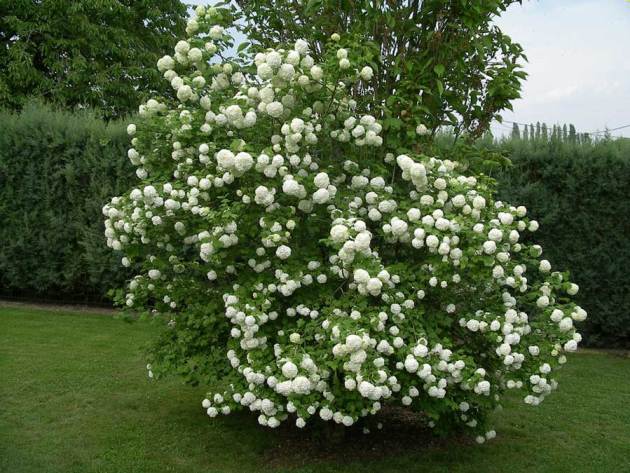
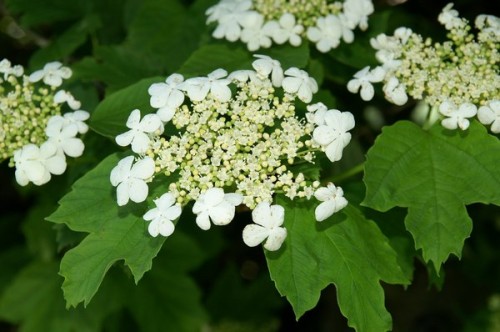
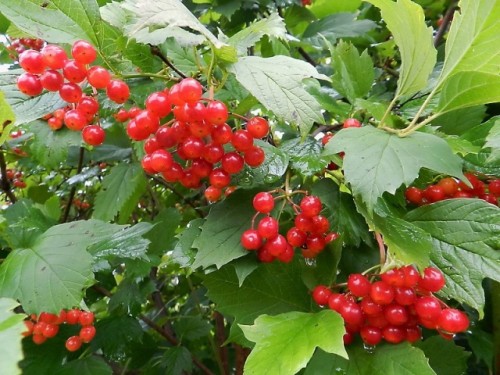
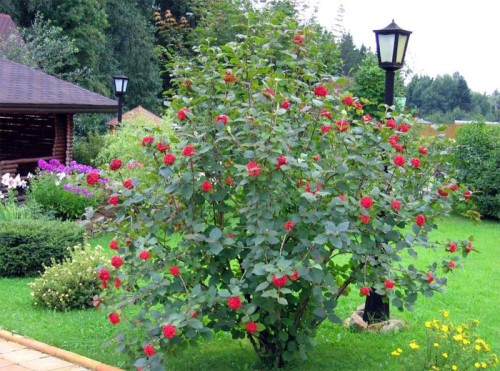

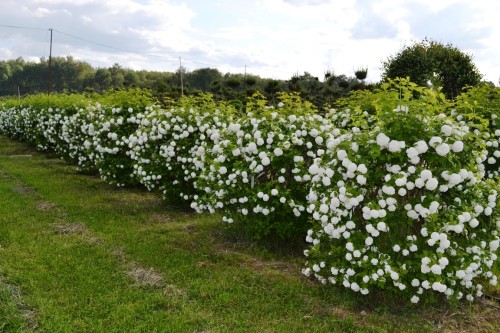
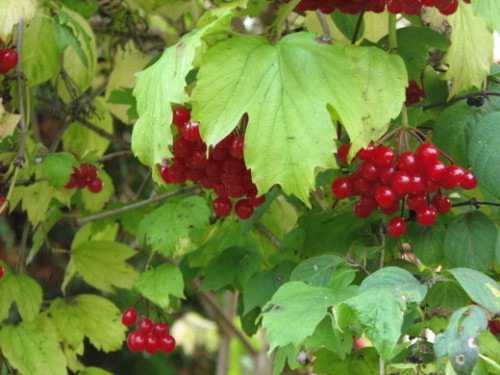
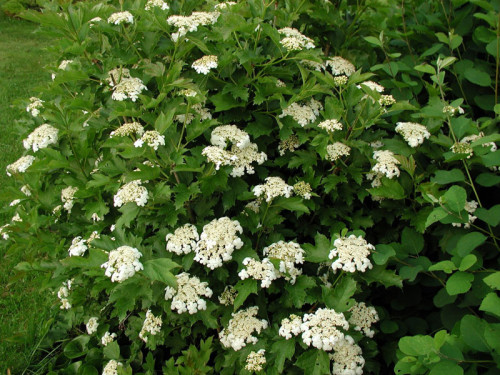
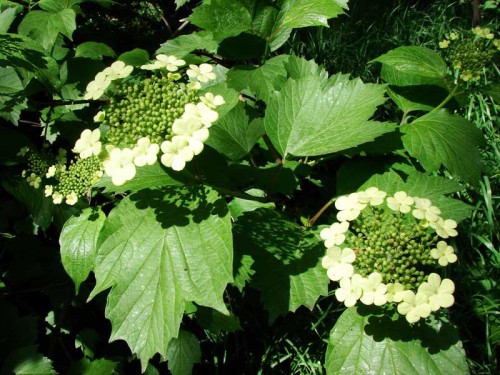
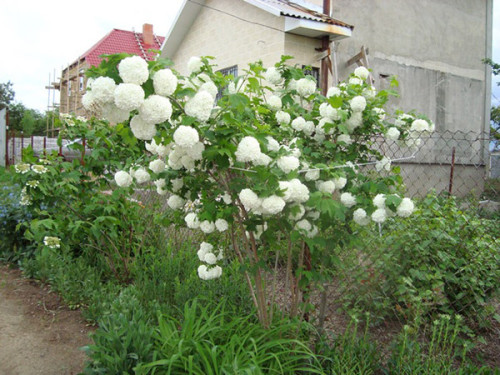
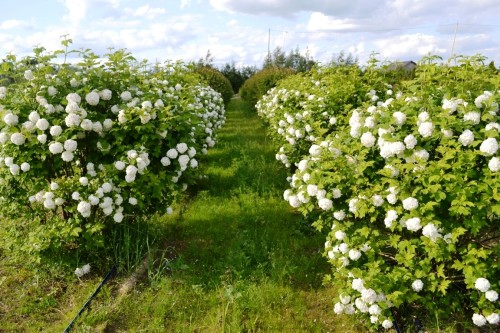












 Start a discussion ...
Start a discussion ...